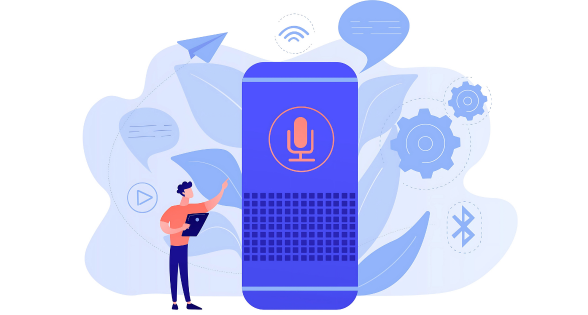Voice assistants have changed how we use technology, making it easy to do simple tasks and manage complex systems. In 2025, these assistants will be smarter, quicker, and more personal, helping us in many ways. This blog looks at the new trends in voice assistants and how they are making a difference in our daily lives.
The Evolution of Voice Assistants
Voice assistants began as simple tools to answer questions or set reminders. Early systems like Siri and Alexa responded to basic queries, but their capabilities were limited. Over the years, significant advancements in artificial intelligence (AI) and machine learning (ML) have transformed these assistants into sophisticated tools.
Today, voice assistants are more than just digital helpers. They act as virtual assistants, capable of controlling devices, completing tasks, and adapting to user preferences. In 2025, the evolution continues as these systems integrate deeper into our lives, improving efficiency and accessibility.
Key Features of Voice Assistants in 2025
1. Enhanced Contextual Understanding
In 2025, voice assistants will understand conversations better than ever. Instead of requiring repetitive commands, they grasp the context of a conversation. For example, If you ask, “Play my favorite song,” and then ask, “Increase the volume,” the assistant understands the context and adjusts the volume.
This improvement stems from advancements in natural language processing (NLP) and contextual AI, which enable them to mimic human conversational patterns. Such features ensure smoother, more intuitive interactions.
2. Multi-Language and Regional Support
As global adoption increases, inclusivity becomes a priority. In 2025, these tools support multiple languages and regional dialects, allowing people from diverse linguistic backgrounds to use them effortlessly. Whether you speak Tamil, Swahili, or Spanish, they provide accurate responses, bridging communication gaps.
3. Hyper-Personalized Experiences
Gone are the days of generic responses. Modern voice assistants analyze user behavior and preferences to deliver tailored solutions. For instance, they recommend songs based on your listening habits or suggest recipes that match your dietary preferences. These personalized experiences make every interaction meaningful.
4. Offline Capabilities
Internet connectivity has always been a limitation for voice assistants. However, in 2025, many assistants can perform basic tasks offline. Whether it’s setting an alarm or controlling connected devices, offline functionality ensures uninterrupted performance, even in areas with poor connectivity.
5. Advanced Privacy and Security
Privacy has been a long-standing concern for users of voice assistants. To address this, manufacturers now offer advanced security features like encrypted data storage, customizable privacy settings, and improved voice recognition. Users can review and delete recordings, ensuring complete control over their data.
6. Seamless Device Integration
Voice assistants now integrate seamlessly across devices. Whether it’s your smartwatch, smartphone, or smart speaker, they provide a unified experience. For example, starting a podcast on your phone and continuing it on your car’s infotainment system happens effortlessly.
Integration with Smart Home Ecosystems
Smart homes are becoming smarter, thanks to these systems. In 2025, they go beyond simple commands like “Turn on the lights.” They now manage energy consumption, optimize appliance usage, and monitor home security.
For example, a command like “Prepare the house for bedtime” triggers multiple actions: dimming lights, locking doors, setting the thermostat, and activating security cameras. This level of automation ensures convenience and safety.
Role in Healthcare
The healthcare sector has seen tremendous benefits from voice assistants In 2025, they help patients track medications, monitor vitals, and schedule appointments. Devices integrated with these systems connect users to healthcare providers in emergencies, offering faster and more reliable support.
Moreover, they now assist in mental health therapy. They engage users in calming exercises, suggest stress-relief techniques, and provide emotional support through conversational AI.
Transforming Education
Education is another area witnessing a revolution. These systems simplify learning by breaking down complex topics and providing quick answers. For students with disabilities, they act as accessibility tools, reading out text or taking notes on command.
Teachers benefit as well. They streamline routine activities like recording attendance, reminding about homework, and automating grading tasks. This enables educators to spend more time teaching and less time handling administrative tasks.
Applications in Business
Businesses leverage these tools to enhance customer experiences. From providing instant responses to queries to automating processes, these tools are invaluable. Many organizations use them for customer service, offering 24/7 assistance and reducing wait times.
They also support workplace productivity. They help employees schedule meetings, set reminders, and retrieve documents, ensuring smoother workflows.
Challenges Faced by Voice Assistants in 2025
Despite their advancements, these systems face challenges that require attention:
- Accuracy in Complex Commands: While they handle most tasks well, understanding nuanced instructions remains a work in progress.
- Privacy Concerns: Although security features have improved, users still worry about data misuse.
- Regional Adaptation: Supporting regional dialects and slang effectively is challenging, as language variations are vast and diverse.
Developers continue working on these issues to make them more reliable and secure.
Future Prospects for Voice Assistants
The future of these tools looks promising. As AI and ML technologies advance, these systems are expected to perform even more complex tasks. They may evolve into full-fledged virtual advisors, capable of guiding users in areas like career planning, advanced healthcare diagnostics, and personalized fitness coaching.
They could also integrate with augmented reality (AR) and virtual reality (VR), enhancing gaming, shopping, and learning experiences. With their potential to adapt and grow, their role in our lives will only expand.
Final Thoughts
In 2025, voice assistants are no longer just tools; they are partners in productivity, convenience, and accessibility. Their ability to adapt, learn, and integrate with our daily routines makes them indispensable. As they continue to evolve, these systems promise a future where technology understands and serves us better than ever.
